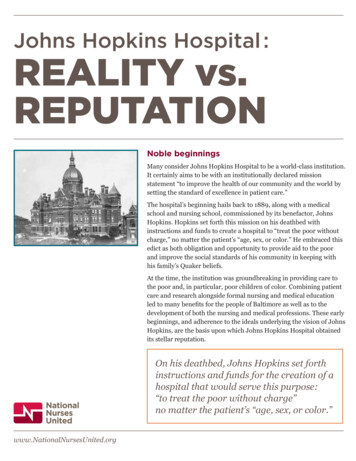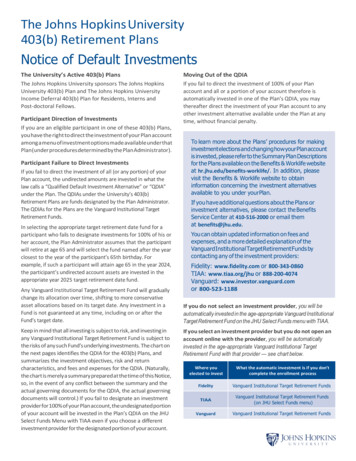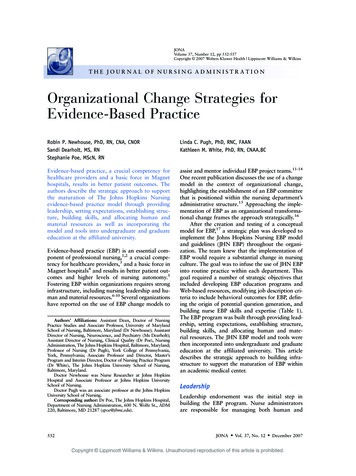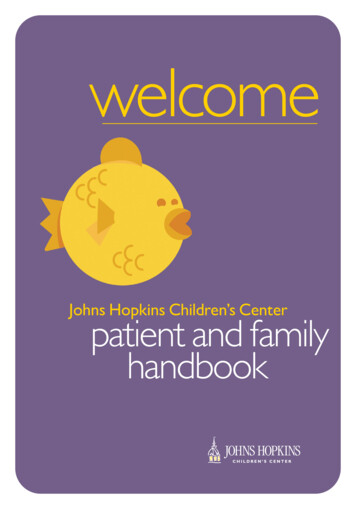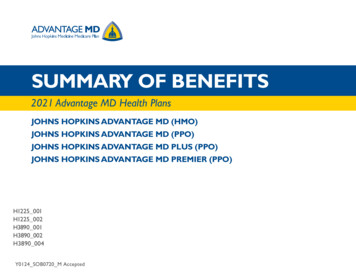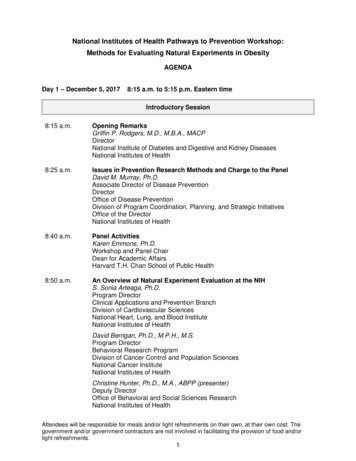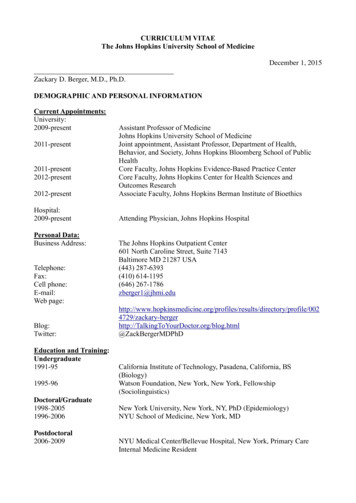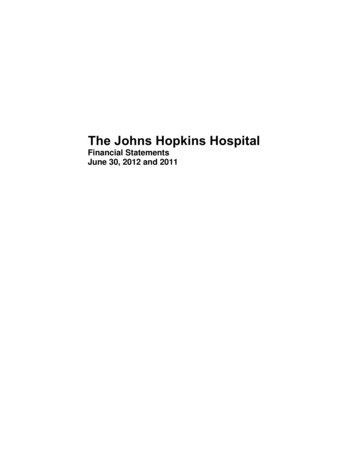
Transcription
The Johns Hopkins HospitalFinancial StatementsJune 30, 2012 and 2011
The Johns Hopkins HospitalIndexJune 30, 2012 and 2011Page(s)Report of Independent Auditors . 1Balance Sheets . 2-3Statements of Operations and Changes in Net Assets . 4Statements of Cash Flows . 5Notes to Financial Statements . 6-36
REPORT OF INDEPENDENT AUDITORSTo the Board of Trustees ofThe Johns Hopkins Hospital:In our opinion, the accompanying balance sheets and the related statements of operations and changesin net assets and cash flows present fairly, in all material respects, the financial position of The JohnsHopkins Hospital (“JHH”) at June 30, 2012 and 2011, and the results of its operations and its cash flowsfor the years then ended in conformity with accounting principles generally accepted in the United Statesof America. These financial statements are the responsibility of JHH’s management. Our responsibilityis to express an opinion on these financial statements based on our audits. We conducted our audits ofthese statements in accordance with auditing standards generally accepted in the United States ofAmerica. Those standards require that we plan and perform the audit to obtain reasonable assuranceabout whether the financial statements are free of material misstatement. An audit includes examining,on a test basis, evidence supporting the amounts and disclosures in the financial statements, assessingthe accounting principles used and significant estimates made by management, and evaluating theoverall financial statement presentation. We believe that our audits provide a reasonable basis for ouropinion.September 28, 2012PricewaterhouseCoopers LLP, 100 East Pratt Street, Suite 1900, Baltimore, MD 21202-1096T: (410) 783 7600, F: (410) 783 7680, www.pwc.com/us
The Johns Hopkins HospitalBalance SheetsJune 30, 2012 and 2011(in thousands)2012ASSETSCurrent assets:Cash and cash equivalentsShort-term investmentsAssets whose use is limited for current liabilitiesPatient accounts receivable, net of estimated uncollectibles of 29,636 and 47,114 at June 30, 2012 and 2011, respectivelyDue from othersDue from affiliates - current portionInventories of suppliesPrepaid expenses and other current assets Total current assetsAssets whose use is limited, net of currentBy donors or grantors for:Future campus developmentPledges receivableBy Board of TrusteesOtherTotal assets whose use is limited, net of currentInvestmentsProperty, plant and equipmentLess: accumulated depreciation and amortizationTotal property, plant and equipment, netDue from affiliates, net of current portionNet pension assetOther assetsTotal assets 41,0748,95012,1522011 848 2,571,300The accompanying notes are an integral part of these financial statements.2
The Johns Hopkins HospitalBalance Sheets, continuedJune 30, 2012 and 2011(in thousands)2012LIABILITIES AND NET ASSETSCurrent liabilities:Current portion of long-term debtAccounts payable and accrued liabilitiesAccrued vacationDue to affiliatesAdvances from third-party payorsCurrent portion of estimated malpractice costs Total current liabilitiesLong-term debt, net of current portionEstimated malpractice costs, net of current portionNet pension liabilityOther long-term liabilitiesTotal liabilitiesNet assets:UnrestrictedTemporarily restrictedTotal net assetsTotal liabilities and net assets 162,625197,09018,24019,72580,25721,8462011 71,4681,209,9222,769,848 2,571,300The accompanying notes are an integral part of these financial statements.3
The Johns Hopkins HospitalStatements of Operations and Changes in Net AssetsFor the years ended June 30, 2012 and 2011(in thousands)2012Operating revenues:Net patient service revenueOther revenueInvestment incomeNet assets released from restrictions used for operations Total operating revenues1,634,266143,36214,0422292011 27,049-(Deficiency) excess of revenues over expenses(55,401)132,934Contributions from affiliatesUnrealized (losses) gains on investmentsChange in funded status of defined benefit plansNet assets released from restrictions used for purchases ofproperty and ncrease in unrestricted net 278,650931,272Operating expenses:Salaries, wages and benefitsPurchased servicesSupplies and otherInterestProvision for bad debtsDepreciation and amortizationTotal operating expensesIncome from operationsNon-operating revenues and expenses:Interest expense on swap agreementsChange in market value of swap agreementsRealized and unrealized (losses) gains on investmentsLoss on advance refunding of debtNon-operating servicesChanges in temporarily restricted net assets:Gifts, grants and bequestsNet assets released from restrictions used for purchase ofproperty, plant and equipmentNet assets released from restrictions used for operationsOther(Decrease) increase in temporarily restricted net assets(Decrease) increase in net assetsNet assets at beginning of yearNet assets at end of year 971,468 1,209,922The accompanying notes are an integral part of these financial statements.4
The Johns Hopkins HospitalStatements of Cash FlowsFor the years ended June 30, 2012 and 2011(in thousands)2012Operating activities:Change in net assetsAdjustments to reconcile change in net assets to net cashand cash equivalents (used in) provided by operating activities:Depreciation, amortization, and accretionProvisions for bad debtsNet realized and unrealized losses (gains) on investmentsChange in market value on swap agreementsChange in funded status of defined benefit plansRestricted contributions and investment income receivedContributions from affiliatesRefunding of debtChanges in assets and liabilities:Patient receivable and due from othersInventories of supplies, prepaid expenses andother current assetsDue (to) from affiliatesPledges receivableOther assetsAccounts payable, accrued liabilities and accrued vacationAdvances from third-party payorsAccrued pension benefit costsOther long-term liabilitiesEstimated malpractice costs Net cash and cash equivalents (used in) provided byoperating activities(238,454)2011 ,294(6,161)8,4211,7952,5569,928Investing activities:Purchases of property, plant, and equipmentPurchases of investment securitiesSales of investment securitiesNet cash and cash equivalents used ininvesting activitiesFinancing activities:Proceeds from restricted contributions and investmentincome receivedProceeds from long-term borrowingRepayment of long-term debtContributions from affiliatesAdvances to affiliates note payableNet cash and cash equivalents (used in) provided byfinancing activitiesDecrease in cash and cash equivalentsCash and cash equivalents at beginning of 2,667(112,314)(99,001)153,388252,389Cash and cash equivalents at end of year 41,074 153,388Supplemental disclosure of noncash transactionsConstruction costs incurred but not paid 33,996 49,626The accompanying notes are an integral part of these financial statements.5
The Johns Hopkins HospitalNotes to the Financial StatementsFor the years ended June 30, 2012 and 2011(in thousands)1.Organization and Summary of Significant Accounting PoliciesOrganization. The Johns Hopkins Health System (“JHHS”) is the sole member of The JohnsHopkins Hospital (“JHH”). JHHS is a not-for-profit organization incorporated in the State ofMaryland to formulate policy among and provide centralized management for JHHS and itsAffiliates. In addition, JHHS provides certain shared services including purchasing, legal,coordination of marketing, and other functions for which JHH is charged separately (see Note 13).JHHS appoints JHH’s Board of Trustees. JHH’s Articles of Incorporation provide that JHHS’Board of Trustees will approve JHH’s annual operating and capital budgets, significantprogrammatic changes at JHH, and other significant changes to JHH including amendments of itsarticles of incorporation or bylaws, mergers, or dissolutions.JHH’s mission is to provide patient care in the treatment and prevention of human illness whichcompares favorably with that rendered by any other institution in the United States or abroad.Use of Estimates. The preparation of financial statements in accordance with accountingprinciples generally accepted in the United States of America requires management to makeestimates and assumptions that affect the reported amounts of assets and liabilities anddisclosure of contingent assets and liabilities at the date of the financial statements and thereported amounts of revenues and expenses during the reporting period. Actual results coulddiffer from those estimates.Basis of Presentation. The accompanying financial statements have been prepared on theaccrual basis of accounting in accordance with accounting principles generally accepted in theUnited States of America.Cash and Cash Equivalents. Cash and cash equivalents include amounts invested in accountswith depository institutions which are readily convertible to cash, with original maturities of threemonths or less. Total deposits maintained at these institutions at times exceed the amountinsured by federal agencies and therefore, bear a risk of loss. JHH has not experienced suchlosses on these funds.Inventories of Supplies. Inventories of supplies are composed of medical supplies, drugs, linen,and parts inventory for repairs. Inventories of supplies are recorded at lower of cost or marketusing a first in, first out method.Assets Whose Use is Limited. Assets whose use is limited or restricted by donor are recorded atfair value at the date of donation, which is then considered cost. Investment income or losses oninvestments of temporarily restricted assets is recorded as an increase or decrease in temporarilyrestricted net assets to the extent restricted by the donor or law. The cost of securities sold isbased on the specific identification method.Assets whose use is limited include assets set aside for future capital improvements, assets heldby trustees under debt agreements, assets restricted by the board of trustees, and assets held formalpractice funding. These assets consist of cash and short term investments, accrued interestand pledges receivable. The carrying amounts reported in the balance sheets approximate fairvalue.6
The Johns Hopkins HospitalNotes to the Financial StatementsFor the years ended June 30, 2012 and 2011(in thousands)Valuation of Investments. Investments in equity securities with readily determinable fair valuesand all investments in debt securities are recorded at fair value in the Balance Sheets(see Note 4). Debt and equity securities traded on a national securities and internationalexchange are valued as of the last reported sales price on the last business day of the fiscal year;investments traded on the over-the-counter market and listed securities for which no sale wasreported on that date are valued at the average of the last reported bid and ask prices.Investments include equity method investments in managed funds, which include hedge funds,private partnerships and other investments which do not have readily ascertainable fair valuesand may be subject to withdrawal restrictions. Investments in hedge funds, private partnerships,and other investments (collectively “alternative investments”), are accounted for under the equitymethod, which approximates fair value. The equity method income or loss from these alternativeinvestments is included in the Statement of Operations and Changes in Net Assets as anunrealized gain or loss within excess of revenues over expenses.Alternative investments are less liquid than JHHs’ other investments. These instruments maycontain elements of both credit and market risk. Such risks include, but are not limited to, limitedliquidity, absence of oversight, dependence upon key individuals, emphasis on speculativeinvestments, and nondisclosure of portfolio composition.Investment income earned on cash balances (interest and dividends) is reported in the operatingincome section of the Statements of Operations and Changes in Net Assets under “Investmentincome.” Realized gains or losses related to the sale of investments, other than temporaryimpairments, and unrealized gains or losses on alternative investments are included in thenon-operating section of the Statement of Operations and Changes in Net Assets included inexcess of revenues over expenses unless the income or loss is restricted by donor or law. Priorto April 1, 2011, unrealized gains or losses on investments other than alternative investments areexcluded from excess of revenues over expenses.On April 1, 2011, JHH changed the classification of certain investments to a trading portfolio fromavailable for sale. Accordingly, cumulative unrealized gains of 12.1 million were reclassified fromunrestricted net assets to non-operating income included in the realized and unrealized gains(losses) on investments within the Statement of Operations and Changes in Net Assets. Thischange was made as management’s intent with respect to the nature of the investment portfolioshas changed.Investments in companies in which JHH does not have control, but has the ability to exercisesignificant influence over operating and financial policies are accounted for using the equitymethod of accounting, and operating results flow through the investment income on theStatements of Operations and Changes in Net Assets. Dividends paid are recorded as areduction of the carrying amount of the investment.Investments in companies in which JHH does not have control, nor has the ability to exercisesignificant influence over operating and financial policies are accounted for using the cost methodof accounting. Investments are originally recorded at cost, with dividends received beingrecorded as investment income.7
The Johns Hopkins HospitalNotes to the Financial StatementsFor the years ended June 30, 2012 and 2011(in thousands)Property, Plant and Equipment. Property, plant and equipment acquisitions are recorded at cost.Equipment is recorded as an asset if the individual cost is at least 5 thousand and the useful lifeis at least three years. Renovation projects of 5 thousand or greater are capitalized in total eventhough individual components are less than the capital limit. The amount capitalized forequipment, buildings, and renovation projects financed by debt would include the interest costsincurred on borrowed funds, net of income earned, during the period of construction of capitalassets and is capitalized as a component of the cost of acquiring those assets. Depreciation andamortization are determined by use of the straight-line method over an estimated useful life of theasset or the remaining life of the lease, whichever is shorter. Estimated useful lives assigned byJHH range from 5 to 25 years for land improvements, 3 to 40 years for buildings andimprovements, 3 to 25 years for fixed and movable equipment, and 5 to 10 years for leaseholdimprovements. Maintenance and repair costs are expensed as incurred. When property, plantand equipment are retired, sold or otherwise disposed of, the asset’s carrying amount and relatedaccumulated depreciation are removed from the accounts and any gain or loss is included inoperations.The cost of software is capitalized provided the cost of the project is at least 100 thousand andthe expected life is at least two years. Costs include payment to vendors for the purchase ofsoftware and assistance in its installation, payroll costs of employees directly involved in thesoftware installation, and the interest costs of the software project if financed by debt. Preliminarycosts to document system requirements, vendor selection, and any costs before softwarepurchase are expensed. Capitalization of costs will generally end when the project is completedand the software is ready to be used. Where implementation of the project is in phases, onlythose costs incurred which further the development of the project will be capitalized. Costsincurred to maintain the system are expensed.Gifts of long-lived assets such as land, buildings or equipment are reported as unrestrictedsupport, and are excluded from the excess of revenues over expenses, unless explicit donorstipulations specify how the donated assets must be used. Gifts of long-lived assets with explicitrestrictions that specify how the assets are to be used and gifts of cash or other assets that mustbe used to acquire long-lived assets are reported as restricted support. Absent explicit donorstipulations about how long those long-lived assets must be maintained, expiration of donorrestrictions are reported when the donated or acquired long-lived assets are placed into service.Impairment of Long-Lived Assets. Long-lived assets are reviewed for impairment when eventsand circumstances indicate that the carrying amount of an asset may not be recoverable. JHH’spolicy is to record an impairment loss when it is determined that the carrying amount of the assetexceeds the sum of the expected undiscounted future cash flows resulting from use of the assetand its eventual disposition. Impairment losses are measured as the amount by which thecarrying amount of the asset exceeds its fair value. Long-lived assets to be disposed of arereported at the lower of the carrying amount or fair value less cost to sell. There were noimpairment charges for the years ended June 30, 2012 and 2011.Financing Expenses. Financing expenses incurred in connection with the issuance by theMaryland Health and Higher Educational Facilities Authority (“MHHEFA”) of long-term debt havebeen capitalized and are included in other assets in the Balance Sheet. Unamortized financingexpenses were 4.9 million and 4.3 million at June 30, 2012 and 2011, respectively. Theseexpenses are being amortized over the term of the related bond issues using the effective interestmethod. Amortization expense for the years ended June 30, 2012 and 2011 was .5 million and .2 million, respectively.8
The Johns Hopkins HospitalNotes to the Financial StatementsFor the years ended June 30, 2012 and 2011(in thousands)Accrued Vacation. JHH records a liability for amounts due to employees for future absenceswhich are attributable to services performed in the current and prior periods.Estimated Malpractice Costs. The provision for estimated medical malpractice claims includesestimates of the ultimate gross costs for both reported claims and claims incurred but notreported. Additionally, an insurance recovery has been recorded representing the amountexpected to be recovered from the self insured captive insurance company.Swap Agreements. The value of the interest rate swap agreements entered into by JHH areadjusted to market value monthly at the close of each accounting period based upon quotationsfrom market makers. The change in market value, if any, is recorded in the Statement ofOperations and Changes in Net Assets. Entering into interest rate swap agreements involves, tovarying degrees, elements of credit, default, prepayment, market and documentation risk inexcess of the amounts recognized on the Balance Sheets. Such risks involve the possibility thatthere will be no liquid market for these agreements, the counterparty to these agreements maydefault on its obligation to perform and there may be unfavorable changes in interest rates.Asset Retirement Obligations. The Financial Accounting Standards Board’s (“FASB”) guidanceon accounting for asset retirement obligations provides for the recognition of an estimated liabilityfor legal obligations associated with the retirement of tangible long-lived assets, includingobligations that are conditional upon a future event. JHH measures asset retirement obligationsat fair value when incurred and capitalizes a corresponding amount as part of the book value ofthe related long-lived assets. The increase in the capitalized cost is included in determiningdepreciation expense over the estimated useful life of these assets. Since the fair value of theasset retirement obligation is determined using a present value approach, accretion of theobligation due to the passage of time until its settlement is recognized each year as part ofdepreciation and amortization expense in JHH’s Statements of Operations and Changes in NetAssets.Temporarily Restricted Net Assets. Temporarily restricted net assets are those whose use hasbeen limited by donors or law to a specific time period or purpose.Donor Restricted Gifts. Unconditional promises to give cash and other assets are reported at fairvalue at the date the promise is received. Unconditional promises to give cash to JHH greaterthan one year are discounted using a rate of return that a market participant would expect toreceive at the date the pledge is received. Conditional promises to give and indications ofintentions to give are reported at fair value at the date the gift is received. The gifts are reportedas temporarily restricted support if they are received with donor stipulations that limit the use ofthe donated assets. When a donor restriction expires, that is, when a stipulated time restrictionends or purpose restriction is accomplished, temporarily restricted net assets are reclassified tounrestricted net assets and reported in the Statements of Operations and Changes in Net Assetsas net assets released from restrictions. Donor restricted contributions, whose restrictions aremet within the same year as received, are reported as unrestricted contributions in theaccompanying financial statements.Grants. JHH receives various grants from individuals and agencies of Federal and StateGovernments for the purpose of furthering its mission of providing patient care. Grants arerecognized as support and the related project costs are recorded as expenses when servicesrelated to grants are incurred. Grants receivable are included in due from others, and grantincome is included in other revenue in the accompanying financial statements.9
The Johns Hopkins HospitalNotes to the Financial StatementsFor the years ended June 30, 2012 and 2011(in thousands)Excess of revenues over expenses. The Statements of Operations and Changes in Net Assetsinclude “Excess of revenues over expenses.” Changes in unrestricted net assets which areexcluded from excess of revenues over expenses, consistent with industry practice, include,among other items, changes in unrealized gains and losses on investments other than tradingsecurities, changes in funded status of defined benefit plans, cumulative effect of changes inaccounting principle, permanent transfers of assets to and from affiliates for other than goods andservices, and contributions of long-lived assets (including assets acquired using contributionswhich by donor restriction were to be used for the purposes of acquiring such assets).Non-operating services. JHH has entered into an agreement effective July 1, 2011 to supportcapital improvements to the Johns Hopkins University School of Medicine’s (“JHUSOM”)infrastructure at the Johns Hopkins Hospital’s East Baltimore campus through annualcontributions. These contributions are recognized each year as non-operating services in JHH’sStatements of Operations and Changes in Net Assets.Income Taxes. JHH qualifies under Section 501(c)(3) of the Internal Revenue Code and is,therefore, not subject to tax under current income tax regulations.FASB’s guidance on accounting for uncertainty in income taxes clarifies the accounting foruncertainty of income tax positions. This guidance defines the threshold for recognizing taxreturn positions in the financial statements as “more likely than not” that the position issustainable, based on its technical merits. This guidance also provides guidance on themeasurement, classification and disclosure of tax return positions in the financial statements.There was no impact on JHH’s financial statements during the years ended June 30, 2012 and2011 resulting from this guidance.New Accounting Standards. Effective July 1, 2011, JHH adopted the provisions of ASU 2010-06,“Improving Disclosures about Fair Value Measurements”, which affects entities required to makedisclosures about recurring and nonrecurring fair value measurements. This ASU requires thatthe Level 3 fair value roll forward activity be displayed gross, breaking out the purchases,issuances, sales and settlement activity. The adoption of this ASU did not have a significantimpact on JHH’s disclosures.Effective July 1, 2011, JHH adopted the provisions of ASU 2010-23, “Measuring Charity Care forDisclosure”, which states that direct and indirect cost be used as the measurement basis forcharity care disclosure purposes and that the method used to determine such costs also bedisclosed. The adoption of this ASU had no impact on JHH’s financial condition, results ofoperations or cash flows.Effective July 1, 2011, JHH adopted the provisions of ASU 2010-24, “Presentation of InsuranceClaims and Related Insurance Recoveries”, which clarifies that health care entities should not netinsurance recoveries against the related claims liabilities.10
The Johns Hopkins HospitalNotes to the Financial StatementsFor the years ended June 30, 2012 and 2011(in thousands)In connection with JHH’s adoption of ASU 2010-24, JHH recorded an increase in its assets andliabilities in the accompanying consolidated Balance Sheet as of June 30, 2012 as follows:Caption on Balance Sheet2012Prepaid expense and other current assetsOther assetsTotal assets Current portion of estimated malpractice costsEstimated malpractice costs, net of current portionTotal liabilities 20,67026,09546,76520,67026,09546,765The assets and liabilities represent JHH’s estimated self-insured captive insurance recoveries forclaims reserves and certain claims in excess of self-insured retention levels. The insurancerecoveries and liabilities have been allocated between short-term and long-term assets andliabilities based upon the expected timing of the claims payments. The adoption had no impacton JHH’s results of operations or cash flows.2.Net Patient Service RevenueJHH has agreements with third-party payors that provide for payments to JHH at amountsdifferent from its established rates. Payment arrangements include prospectively determinedrates per discharge, reimbursed costs, discounted charges, and per diem payments. Net patientservice revenue is reported at the estimated net realizable amounts from patients, third-partypayors, and others for services rendered including estimated retroactive adjustments underreimbursement agreements with third-party payors. Retroactive adjustments are accrued on anestimated basis in the period the related services are rendered and adjusted in future periods asfinal settlements are determined. Adjustments mandated by the Health Services Cost ReviewCommission are also included in contractual adjustments, a portion of which are also included inestablished rates.JHH has a policy of providing care to patients who meet certain criteria under its charity carepolicy without charge or at amounts less than its established rates. Such patients are identifiedbased on information obtained from the patient and subsequent analysis. Because JHH does notpursue collection of amounts determined to qualify as charity care, they are not reported asrevenue. Direct and indirect costs for these services amounted to 29.2 million and 26.6 millionfor the years ended June 30, 2012 and 2011, respectively. The costs of providing charity careservices are based on a calculation which applies a ratio of costs to charges to the grossuncompensated charges associated with providing care to charity patients. The ratio of cost tocharges is calculated based on JHH’s total expenses (less bad debt expense) divided by grosspatient service revenue.11
The Johns Hopkins HospitalNotes to the Financial StatementsFor the years ended June 30, 2012 and 2011(in thousands)Patient accounts receivable as of June 30 consisted of the following:2012Medicare programBlue Cross and Blue Shield of MarylandHealth Maintenance OrganizationsCommercialMedicaid programMedicaid Managed Care OrganizationsOther self-pay and third 3%%%%%%%Pledges ReceivableAs of June 30, 2012 and 2011, the total value of pledges receivable was 15.7 million and 26.7million, before discounts. These amounts have been discounted at rates ranging from 1.38% to6.0% and consist
The Johns Hopkins Hospital Notes to the Financial Statements For the years ended June 30, 2012 and 2011 (in thousands) 6 1. Organization and Summary of Significant Accounting Policies Organization. The Johns Hopkins Health System ("JHHS") is the sole member of The Johns Hopkins Hospital ("JHH").



